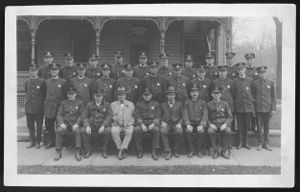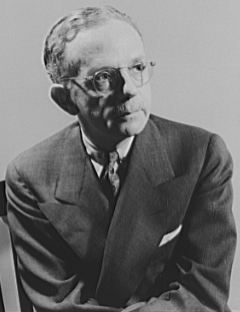Jake Campbell
August 7, 1930
On August 7, 1930 three men Tom Shipp aged nineteen, Abe Smith, eighteen, and James Cameron sixteen, were dragged from their cells in the Grant Country Jail and hanged (Madison 36-63). These three men were in jail awaiting trial on a supposed rape and murder charge ("Indianapolis Star" Page1). During this famous lynching, Grant County Sheriff Jake Campbell was overseeing the local jail ("Indianapolis Star" Page1). People began to gather in front of the jail around 6:30 p.m. on a warm Thursday evening. Without warning the mob grew out of control and stormed the jail. It was said that Sheriff Campbell did not do his job to the best of his ability, and in some ways almost let them walk into the jail. In some records witnesses say that Sheriff Campbell actually handed the angry mob the keys to the young men's cells ("Herald Press" Pg 1). Many people may say that Jake Campbell could have easily prevented the lynching, but instead he stepped aside ("Herald Press" Pg 1).
Ties With the KKK
Campbell was said to possibly have ties with the notorious Ku Klux Klan (Madison 36-63). It was not uncommon at this time for a sheriff or person with higher power to have direct ties to the Klan ("Muncie Evening Press" Page 1). Although Jake was never proven to be a Klan member it seems to make sense that he would be, because of his lack of protection for the three young African American men. Although there is a lack of reliable evidence, many would be left to believe that the Klan played a part in the Lynching, and that Campbell in some way knew of the Klan's intentions ("Herald Press" Pg 1). There have also been theories that state Campbell's lack of action could have been due to acts of intimidation against him, by the Klan members ("Muncie Evening Press" Page 1).
Walter White and the NAACP
During the time of the lynching fear was not only spread among the African Americans, but also the white residents of Marion (Madison 36-63). It was reported that as many as four hundered African Americans were gathered in Johnstown, ready to march to Marion. Police reached the group and broke them up before they were able to carry out with their plans. One of their main targets was said to be Sheriff Campbell, who was under heavy protection in his jail residence (Madison 36-63). Walter White, acting head of the NAACP, was brought to Marion in attempt to prosecute the lynchers, and law officers (Madison 36-63). White came to the the conclusion that the officers were guilty of "gross if not criminal negligence." White also concluded that it was "beyond question that Sheriff Campbell was guilty of gross failure to perform his duty as sheriff," and that he should be removed from office (Madison 36-63). Grant County Prosecuter Harley Hardin told White that he was "reluctant to proceed vigorously with the arrest and prosecution of the lynchers and law officers, basing this reluctance upon the fact that he feared such action would infuriate the mob and stir it to new activity" (Madison 36-63).
Works Cited
Madison, James. A Lynching in the Heartland. 1st. New York: Palgrave, 2001 36-63. Print.
"Marion Sheriff May Face Duty Failure Charge." Herald Press August 1930: Pg 1 . Print.
"Sheriff May Be Held To Blame." Muncie Evening Press August 1930: Page 1. Print.
"Sheriff Asks Aid As Race Leaders Predict Violence." Indianapolis Star August 1930: Page 1. Print.
Credits
This article was written by Matt Mast in May 2011 for Mr. Munn's ACP American History class.

